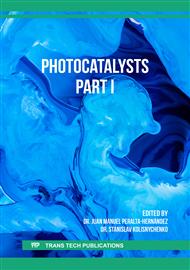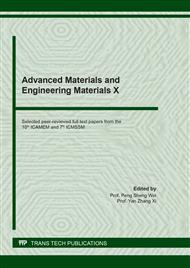[1]
Wood D, Shaw S, Cawte T, Shanen E, Van Heyst B. An overview of photocatalyst immobilization methods for air pollution remediation. Chemical Engineering Journal. 2020;391.
DOI: 10.1016/j.cej.2019.123490
Google Scholar
[2]
Zhu D, Zhou Q. Action and mechanism of semiconductor photocatalysis on degradation of organic pollutants in water treatment: A review. Environmental Nanotechnology, Monitoring & Management. 2019;12.
DOI: 10.1016/j.enmm.2019.100255
Google Scholar
[3]
Pichat P. A brief survey of the practicality of using photocatalysis to purify the ambient air (indoors or outdoors) or air effluents. Applied Catalysis B: Environmental. 2019;245:770-6.
DOI: 10.1016/j.apcatb.2018.12.027
Google Scholar
[4]
Byrne C, Subramanian G, Pillai SC. Recent advances in photocatalysis for environmental applications. Journal of Environmental Chemical Engineering. 2018;6:3531-55.
DOI: 10.1016/j.jece.2017.07.080
Google Scholar
[5]
Al-Mamun MR, Kader S, Islam MS, Khan MZH. Photocatalytic activity improvement and application of UV-TiO2 photocatalysis in textile wastewater treatment: A review. Journal of Environmental Chemical Engineering. 2019;7.
DOI: 10.1016/j.jece.2019.103248
Google Scholar
[6]
Basavarajappa PS, Patil SB, Ganganagappa N, Reddy KR, Raghu AV, Reddy CV. Recent progress in metal-doped TiO2, non-metal doped/codoped TiO2 and TiO2 nanostructured hybrids for enhanced photocatalysis. International Journal of Hydrogen Energy. 2020;45:7764-78.
DOI: 10.1016/j.ijhydene.2019.07.241
Google Scholar
[7]
Tian H, Ma J, Li K, Li J. Hydrothermal synthesis of S-doped TiO2 nanoparticles and their photocatalytic ability for degradation of methyl orange. Ceramics International. 2009; 35: 1289-92.
DOI: 10.1016/j.ceramint.2008.05.003
Google Scholar
[8]
Verbruggen SW. TiO2 photocatalysis for the degradation of pollutants in gas phase: From morphological design to plasmonic enhancement. Journal of Photochemistry and Photobiology C: Photochemistry Reviews. 2015;24:64-82.
DOI: 10.1016/j.jphotochemrev.2015.07.001
Google Scholar
[9]
He Ra, Cao S, Zhou P, Yu J. Recent advances in visible light Bi-based photocatalysts. Chinese Journal of Catalysis. 2014;35:989-1007.
DOI: 10.1016/s1872-2067(14)60075-9
Google Scholar
[10]
Talasila G, Sachdev S, Srivastva U, Saxena D, Ramakumar SSV. Modified synthesis of BiVO4 and effect of doping (Mo or W) on its photoelectrochemical performance for water splitting. Energy Reports. 2020;6:1963-72.
DOI: 10.1016/j.egyr.2020.07.024
Google Scholar
[11]
Sajid MM, Amin N, Shad NA, khan SB, Javed Y, Zhang Z. Hydrothermal fabrication of monoclinic bismuth vanadate (m-BiVO4) nanoparticles for photocatalytic degradation of toxic organic dyes. Materials Science and Engineering: B. 2019;242:83-9.
DOI: 10.1016/j.mseb.2019.03.012
Google Scholar
[12]
Li X, Xu L, Li X, Hu M, Huang R, Huang C. Oxidant peroxo-synthesized monoclinic BiVO4: Insights into the crystal structure deformation and the thermochromic properties. Journal of Alloys and Compounds. 2019;787:666-71.
DOI: 10.1016/j.jallcom.2019.02.136
Google Scholar
[13]
Lin Y, Lu C, Wei C. Microstructure and photocatalytic performance of BiVO4 prepared by hydrothermal method. Journal of Alloys and Compounds. 2019;781:56-63.
DOI: 10.1016/j.jallcom.2018.12.071
Google Scholar
[14]
Ma W, Li Z, Liu W. Hydrothermal preparation of BiVO4 photocatalyst with perforated hollow morphology and its performance on methylene blue degradation. Ceramics International. 2015;41:4340-7.
DOI: 10.1016/j.ceramint.2014.11.123
Google Scholar
[15]
Samsudin MFR, Bashiri R, Mohamed NM, Ng YH, Sufian S. Tailoring the morphological structure of BiVO4 photocatalyst for enhanced photoelectrochemical solar hydrogen production from natural lake water. Applied Surface Science. 2020;504.
DOI: 10.1016/j.apsusc.2019.144417
Google Scholar
[16]
Zhang G, Sun Z, Duan Y, Ma R, Zheng S. Synthesis of nano-TiO2 /diatomite composite and its photocatalytic degradation of gaseous formaldehyde. Applied Surface Science. 2017;412:105-12.
DOI: 10.1016/j.apsusc.2017.03.198
Google Scholar
[17]
Ma J, Chen J, Wang B, Cai S. The in-situ growth of BiVO4 coatings on carbon fibers and their photocatalytic performance. Materials Research Bulletin. 2016;77:253-7.
DOI: 10.1016/j.materresbull.2016.01.047
Google Scholar
[18]
Chen Y, Wu Q, Liu L, Wang J, Song Y. The fabrication of self-floating Ti3+/N co-doped TiO2/diatomite granule catalyst with enhanced photocatalytic performance under visible light irradiation. Applied Surface Science. 2019;467-468:514-25.
DOI: 10.1016/j.apsusc.2018.10.146
Google Scholar
[19]
Dong X, Ren B, Zhang X, Liu X, Sun Z, Li C, et al. Diatomite supported hierarchical 2D CoNi3O4 nanoribbons as highly efficient peroxymonosulfate catalyst for atrazine degradation. Applied Catalysis B: Environmental. 2020;272.
DOI: 10.1016/j.apcatb.2020.118971
Google Scholar
[20]
Niu L, Xian G, Long Z, Zhang G, Zhou N. MnCeO /diatomite catalyst for persulfate activation to degrade organic pollutants. Journal of Environmental Sciences. 2020;89:206-17.
DOI: 10.1016/j.jes.2019.09.020
Google Scholar
[21]
Fan H-B, Ren Q-F, Wang S-L, Jin Z, Ding Y. Synthesis of the Ag/Ag3PO4/diatomite composites and their enhanced photocatalytic activity driven by visible light. Journal of Alloys and Compounds. 2019;775:845-52.
DOI: 10.1016/j.jallcom.2018.10.152
Google Scholar
[22]
Chen Y, Wu Q, Liu L, Wang J, Song Y. The fabrication of floating Fe/N co-doped titania/diatomite granule catalyst with enhanced photocatalytic efficiency under visible light irradiation. Advanced Powder Technology. 2019;30:126-35.
DOI: 10.1016/j.apt.2018.10.014
Google Scholar
[23]
Han X, Lü J, Tian L, Kong L, Lu X, Mei Y, et al. Ag-loaded mesoporous Pb3Nb2O8 photocatalysts with enhanced activity under visible-light irradiation. Chinese Journal of Catalysis. 2017;38:83-91.
DOI: 10.1016/s1872-2067(16)62575-5
Google Scholar
[24]
Basavalingaiah KR, Udayabhanu, Harishkumar S, Nagaraju G, Chikkahanumantharayappa. Uniform deposition of silver dots on sheet like BiVO4 nanomaterials for efficient visible light active photocatalyst towards methylene blue degradation. FlatChem. 2020;19.
DOI: 10.1016/j.flatc.2019.100142
Google Scholar
[25]
He F, Wang S, Zhao H, Wang Y, Zhang J, Yan Q, et al. Construction of Schottky-type Ag-loaded fiber-like carbon nitride photocatalysts for tetracycline elimination and hydrogen evolution. Applied Surface Science. 2019;485:70-80.
DOI: 10.1016/j.apsusc.2019.04.164
Google Scholar
[26]
Nahar S, Hasan MR, Kadhum AAH, Hasan HA, Zain MFM. Photocatalytic degradation of organic pollutants over visible light active plasmonic Ag nanoparticle loaded Ag2SO3 photocatalysts. Journal of Photochemistry and Photobiology A: Chemistry. 2019;375:191-200.
DOI: 10.1016/j.jphotochem.2019.02.025
Google Scholar
[27]
Shawky A, Mohamed RM, Mkhalid IA, Youssef MA, Awwad NS. Visible light-responsive Ag/LaTiO3 nanowire photocatalysts for efficient elimination of atrazine herbicide in water. Journal of Molecular Liquids. 2020;299.
DOI: 10.1016/j.molliq.2019.112163
Google Scholar
[28]
Gnanasekaran L, Hemamalini R, Rajendran S, Qin J, Yola ML, Atar N, et al. Nanosized Fe3O4 incorporated on a TiO2 surface for the enhanced photocatalytic degradation of organic pollutants. Journal of Molecular Liquids. 2019;287.
DOI: 10.1016/j.molliq.2019.110967
Google Scholar
[29]
He K, Yan M, Huang Z, Zeng G, Chen A, Huang T, et al. Fabrication of ploydopamine–kaolin supported Ag nanoparticles as effective catalyst for rapid dye decoloration. Chemosphere. 2019; 219: 400-8.
DOI: 10.1016/j.chemosphere.2018.12.012
Google Scholar



